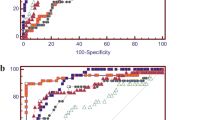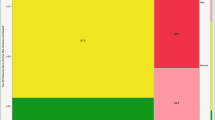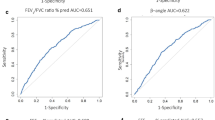Abstract
Pulmonary function testing plays a key role in the diagnosis and management of asthma in children. However, the literature does not clearly show whether children with clinically stable asthma have significantly reduced lung function when compared with normal children. We compared the lung function of 242 clinically stable asthmatic children who were initially diagnosed with mild intermittent or mild persistent asthma with the lung function of 100 nonasthmatic controls. The lung function was assessed using FEV1, FEV1/FVC, FEF25–75 and PEF. In addition, we measured bronchial hyperresponsiveness (BHR) using the provocation concentration of methacholine needed to produce a 20% fall in FEV1. All measures of pulmonary function were significantly decreased in the children with asthma. Pulmonary function was not influenced by atopy, serum IgE, or total eosinophil count (TEC). However, the likelihood ratio for trends revealed a significant association between our pulmonary parameters and the degree of BHR. Children with mild-to-severe BHR had greatly decreased lung function compared with those with normal BHR, the control group. In addition, a direct correlation was found between PC20 and our pulmonary parameters in asthmatic children. However, only atopic children with asthma had a significant correlation between PC20 and TEC. We found children with clinically stable asthma to have pulmonary obstruction, which associated strongly with their degree of BHR.




Similar content being viewed by others
References
American Thoracic Society (1993) Guidelines for the evaluation of impairment/disability in patients with asthma. A statement of the American Thoracic Society. Am Rev Respir Dis 147:1202–1218
Barnes PJ (1998) Current issues for establishing inhaled corticosteroids as the anti-inflammatory agents of choice; in asthma. J Allergy Clin Immunol 101:427–433
Beehn KM, Ksoll M, Buhl R (2000) Elevation of total serum immunologlobulin E is associated with asthma in nomallergic individuals. Eur Respir J 16:609–614
Boushey MI, Holtzman MJ, Sheller JR, Nadel JA (1980) Bronchial hyperreactivity. Am Rev Respir Dis 121:389–413
Buist SA, Vollmer WM (1987) Prospective investigations in asthma. What have we learned from longitudinal studies about lung growth and senescence in asthma? Chest 91(Suppl 6):119–126
Catherine L, Corinne W, Denjse O, et al. (2001) Differential cell counts in sputum in respiratory epidemiology. Chest 120:1107–1113
Clough JB, Holgate ST (1994) Episodes of respiratory morbidity in children with cough and wheeze. Am J Respir Crit Care Med 150:48–53
Crapo RO, Casaburi R, Coates AL, et al. (2000) Guidelines for methacholine and exercise challenge testing—1999. This official statement of the American Thoracic Society was adopted by the ATS Board of Directors, July 1999. Am J Respir Crit Care Med 161:309–329
Crimi E, Spanevello A, Neri M, et al. (1998) Dissociation between airway inflammation and airway hyperresponsiveness in allergic asthma. Am J Respir Crit Care Med 157:4–9
Dodge RR, Burrows B (1980) The prevalence and incidence of asthma and asthma-like symptoms in a general population sample. Am Rev Respir Dis 122:567–575
Dupont C, Antonini MT, Denoyer M, et al. (1987) The value of respiratory function test in’the surveillance of asthmatic children. Allerg Immuno (Paris) 19:135–141
Fish JE, Peters SP (1999) Airway remodeling and persistent airway obstruction in asthma. J Allergy Clinlmmunol 104:509–516
Foo AL, Sly PD (1991) Pulmonary function in a hospital population of asthmatic children. J Asthma 28:273–280
Fuhlbrigge AL, Kitch BT, Paltiel AD, et al. (2001) FEV1 is associated with risk of asthma attacks in a pediatric population. J Allergy Clin Immunol 107:61–61
Gibson PG, Wlodarczyk JW, Hensley MJ, et al. (1998) Epidermiologic association of airway inflammation with asthma symptoms and airway hyperresponsiveness in childhood. Am J Respir Crit Care Med 158:36–41
Global Initiative for Asthma (GINA) (1995) Global strategy for asthma management and prevention. Updated 2002, 2003, NIH publication 02-3659. Available at http://www.ginasthma.com [accessed 26 October 2004]
Gurkan F, Davutoglu M, Bilici M, Sincar N, Haspolat K (2002) Pulmonary functions in atopic and nonatopic asthmatic children. Allergol Immunopathol (Madr) 30(2):70–73
Irnell K, Kiviloog J (1968) Bronchial asthma and chronic bronchitis in a Swedish urban and rural population. Scan J Respir Dis 66:1–86
Jeffery P, Wardlaw A, Nelsoin FC, Collins JV, Kay AB (1989) Bronchial biopsies in asthma: an ultrastructural quantitative study and correlation with hyperreactivity. Am Rev Respir Dis 140:1745–1753
Jenkins MA, Hopper JL, Bowes G, et al. (1996) Factors in childhood to adulthood. Allergy 51:855–869
Kelly WJW, Hudson I, Raven J, et al. (1988) Childhood asthma and adult lung function. Am Rev Respir Dis 138:26–30
Koh YY (1989) Pulmonary function studies in assessment of childhood asthma. Allergy 9:36–46
Lebecque P, Kiakulanda P, Coates AI (1993) Spirometry in asthmatic child: is FEF25–75% a more sensitive test than FEV1/FVC? Pediatr Pulmonol 16:19–22
Male I, Richter H, Seddon P (2000) Children’s perception of breathlessness in acute asthma. Arch Dis Child 83:325–329
Martin AJ, Landau LI, Phenlan PD (1980a) Lung function in young adults who had asthma in childhood. Am Rev Respir Dis 122:609–616
Martin AJ, Mclennan LA, Landau LI, Phenlan PD (1980b) The natural history of childhood asthma to adult life. Br Med J 280:1397–1400
McFadden ER, Linden DA (1972) A reduction in maximum mid-expiratory flow rate: a spirographic manifestation of Small airway disease. Am J Med 52:725–737
Mosfeldt-Laursen E, Kaae-Hansen K, Backer V, et al. (1993) Pulmonary function in adolescents with childhood asthma. Allergy 48:267–272
Nakadate T, Kagawa J (1992) Pulmonary function development in children with past history of asthma. J Epidermilol Community Health 46:437–442
Pizzichini E, Pizzichini MM, Efthimiadis A, Dolovich J, Hargreave FE (1997) Measuring airway inflammation in asthma: eosinophils and eosinophilic cationic protein in induced sputum compared with peripheral blood. J Allergy Clin Immunol 99:539–544
Rasmussen F, Taylor DR, Flannery EM, et al. (2002) Risk factors for hospital admission for asthma from childhood to young adulthood: a longitudinal population study. J Allergy Clin Immunol 309:90–93
Ratageri VH, Kabra SK, Lodha R, Dwivedi SN, Seth V (2001) Lung function tests in asthma: which indices are better for assessment of severity? J Trop Pediatr. 47:57–59
Robert B, Gregory K, Albert Y, Elizabeth L, Anthony M (1995) Spirometric patterns inasthma: Peak flw compared with other indices. Pediatr Pulmonol 20:372–379
Schwartz J, Weiss ST (1995) Relationship of skin test reactivity to decrements in pulmonary function in children with asthma or frequent wheezing. Am J Respir Care Med 152:2176–2180
Sears MR, Burrow B, Flannery EM, et al. (1991) Relation between airway responsiveness and serum JgE in children with asthma and in apparently normal children. N Engl J Med 325:1067–1071
Shapiro BE (1999) The interpretation of diagnostic tests. Stat Methods Med Res 8:113–134
Silvestri M, Oddera S, Crimi P, Rossi GA (1997) Frequency and specific sensitization to inhalant allergens within nuclear families of children with asthma and/or rhinitis allergy. Ann Allergy Asthma Immunol 79:512–516
Silvestri M, Sabatini F, Spallarossa D, et al. (2001) Exhaled nitric oxide levels in non-allergic and allergic mono- or polysensitised children with asthma. Thorax 56:875–864
Stein RT, Holberg CJ, Morgan WJ, et al. (1997) Peak flow variability, methacholine responsiveness and atopy as markers for detecting different wheezing phenotypes in childhood. Thorax 52:946–952
Tabona M, Chan-yeung M, Enarson D, et al. (1984) Host factors affecting longitudinal decline in lung spirometry among grain elevator workers. Chest 85:782–786
The Childhood Asthma Management Program Research Group (2000) Long term effects of budenoside or nedocromil in children with asthma. N Engl J Med 343:1054–1063
Verdiani P, Carlo SD, Baronti A (1990) A different prevalence and degree of nonspecific bronchial hyperreactivity between seasonal and perennial rhinitis. J Allergy Clin Immunol 147:1056–1061
Author information
Authors and Affiliations
Corresponding author
Rights and permissions
About this article
Cite this article
Yang, E., Kim, W., Kwon, B.C. et al. Relationship Among Pulmonary Function, Bronchial Hyperresponsiveness, and Atopy in Children with Clinically Stable Asthma. Lung 184, 73–79 (2006). https://doi.org/10.1007/s00408-005-2565-0
Accepted:
Issue Date:
DOI: https://doi.org/10.1007/s00408-005-2565-0




